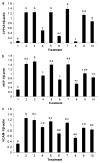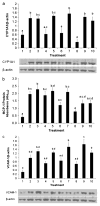PCB 77 dechlorination products modulate pro-inflammatory events in vascular endothelial cells
- PMID: 23504249
- PMCID: PMC3728165
- DOI: 10.1007/s11356-013-1591-3
PCB 77 dechlorination products modulate pro-inflammatory events in vascular endothelial cells
Abstract
Persistent organic pollutants such as polychlorinated biphenyls (PCBs) are associated with detrimental health outcomes including cardiovascular diseases. Remediation of these compounds is a critical component of environmental policy. Although remediation efforts aim to completely remove toxicants, little is known about the effects of potential remediation byproducts. We previously published that Fe/Pd nanoparticles effectively dechlorinate PCB 77 to biphenyl, thus eliminating PCB-induced endothelial dysfunction using primary vascular endothelial cells. Herein, we analyzed the toxic effects of PCB congener mixtures (representative mixtures of commercial PCBs based on previous dechlorination data) produced at multiple time points during the dechlorination of PCB 77 to biphenyl. Compared with pure PCB 77, exposing endothelial cells to lower chlorinated PCB byproducts led to improved cellular viability, decreased superoxide production, and decreased nuclear factor kappa B activation based on duration of remediation. Presence of the parent compound, PCB 77, led to significant increases in mRNA and protein inflammatory marker expression. These data implicate that PCB dechlorination reduces biological toxicity to vascular endothelial cells.
Figures





Similar articles
-
Altered biologic activities of commercial polychlorinated biphenyl mixtures after microbial reductive dechlorination.Environ Health Perspect. 1998 Dec;106 Suppl 6(Suppl 6):1409-18. doi: 10.1289/ehp.98106s61409. Environ Health Perspect. 1998. PMID: 9860899 Free PMC article.
-
Toxicology and carcinogenesis studies of 2,3',4,4',5-pentachlorobiphenyl (PCB 118) (CAS No. 31508-00-6) in female harlan Sprague-Dawley rats (gavage studies).Natl Toxicol Program Tech Rep Ser. 2010 Nov;(559):1-174. Natl Toxicol Program Tech Rep Ser. 2010. PMID: 21383778
-
PCB 9 exposure induces endothelial cell death while increasing intracellular calcium and ROS levels.Environ Toxicol. 2012 Mar;27(3):185-91. doi: 10.1002/tox.20676. Epub 2011 Feb 22. Environ Toxicol. 2012. PMID: 21344606
-
Comprehensive compilation of congener profiles to support health assessment of environmental exposures to polychlorinated biphenyl mixtures.Environ Res. 2024 Dec 15;263(Pt 1):120081. doi: 10.1016/j.envres.2024.120081. Epub 2024 Sep 28. Environ Res. 2024. PMID: 39343341 Review.
-
Effects of polychlorinated biphenyls on the nervous system.Toxicol Ind Health. 2000 Sep;16(7-8):305-33. doi: 10.1177/074823370001600708. Toxicol Ind Health. 2000. PMID: 11693948 Review.
Cited by
-
Gene expression profiling to identify the toxicities and potentially relevant disease outcomes due to endosulfan exposure.Toxicol Res (Camb). 2016 Jan 22;5(2):621-632. doi: 10.1039/c5tx00332f. eCollection 2016 Mar 1. Toxicol Res (Camb). 2016. PMID: 30090376 Free PMC article.
-
Blood Levels of Organochlorine Contaminants Mixtures and Cardiovascular Disease.JAMA Netw Open. 2023 Sep 5;6(9):e2333347. doi: 10.1001/jamanetworkopen.2023.33347. JAMA Netw Open. 2023. PMID: 37698859 Free PMC article.
-
Pdgfrα-Cre mediated knockout of the aryl hydrocarbon receptor protects mice from high-fat diet induced obesity and hepatic steatosis.PLoS One. 2020 Jul 30;15(7):e0236741. doi: 10.1371/journal.pone.0236741. eCollection 2020. PLoS One. 2020. PMID: 32730300 Free PMC article.
-
Modulation of persistent organic pollutant toxicity through nutritional intervention: emerging opportunities in biomedicine and environmental remediation.Sci Total Environ. 2014 Sep 1;491-492:11-6. doi: 10.1016/j.scitotenv.2014.01.109. Epub 2014 Feb 13. Sci Total Environ. 2014. PMID: 24530186 Free PMC article. Review.
-
Exercise protects against PCB-induced inflammation and associated cardiovascular risk factors.Environ Sci Pollut Res Int. 2016 Feb;23(3):2201-11. doi: 10.1007/s11356-014-4062-6. Epub 2015 Jan 15. Environ Sci Pollut Res Int. 2016. PMID: 25586614 Free PMC article.
References
-
- Brown JF, Feng H, Bedard DL, Brennan MJ, Carnahan JC, May RJ. Environmental dechlorination of PCBs. Environ Toxicol Chem. 1987;6(8):579–593. doi: 10.1002/etc.5620060802. - DOI
-
- de Winther MP, Kanters E, Kraal G, Hofker MH. Nuclear factor kappaB signaling in atherogenesis. Arterioscler Thromb Vasc Biol. 2005;25(5):904–914. - PubMed
-
- Doskey PV, Andren AW. Concentrations of airborne PCBs over Lake Michigan. J Great Lakes Res. 1981;7(1):15–20. doi: 10.1016/S0380-1330(81)72018-5. - DOI
Publication types
MeSH terms
Substances
Grants and funding
LinkOut - more resources
Full Text Sources
Other Literature Sources

